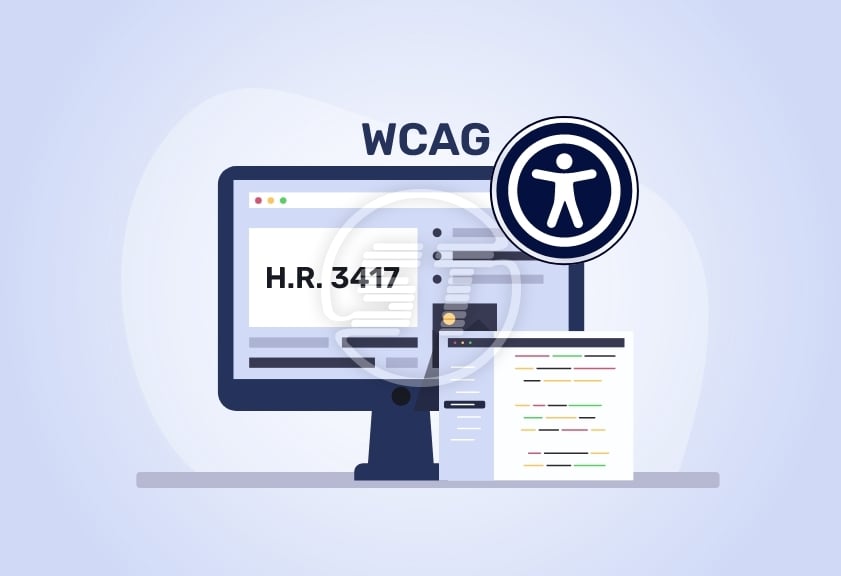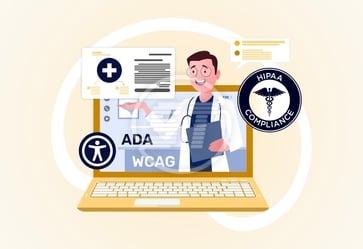For decades, digital accessibility in the U.S. has been guided by outdated frameworks written for an old environment that looked nothing like today’s. Websites have evolved into complex ecosystems of multimedia, mobile apps, digital forms, AI chatbots, and automated service platforms. However, accessibility laws were the same - leaving organizations with many technical loopholes and excluding users with disabilities often from full participation in the digital economy.
And then H.R. 3417 brought a modern shift in digital accessibility!
Its introduction is a pivotal shift in how digital accessibility is viewed and enforced across the United States. As technology evolves, so must the policies ensure equal digital access for people with disabilities. This bill redefines the nation’s accessibility approach - updating frameworks, strengthening enforcement, and aligning with the realities of today’s interconnected digital economy.
What is H.R. 3417 - Websites and Software Applications Accessibility Act?
H.R. 3417, also known as the 21st Century Web Accessibility Act, is designed to clarify, update, and unify digital accessibility standards under the Americans with Disabilities Act (ADA) and related federal regulations. It bridges long-standing gaps between outdated compliance models and the latest digital transformations that shapes modern customers’ life and every business.
The bill specifically focuses on:
- Eliminating grey areas that have led to inconsistent court rulings about web accessibility.
- Defining accessibility for modern technology - including websites, mobile apps, PDFs, kiosks, and AI-driven tools.
- Establishing uniform digital accessibility standards aligned with WCAG 2.2.
- Expanding coverage beyond government and public sectors to include businesses, educational institutions, and service providers.
- Encouraging proactive audits and remediation, not just reactive legal compliance.
How does H.R. 3417 redefine accessibility?
- Broader scope of digital environments
- Clear federal standards
- Enhanced accountability and reporting
- Promotion of innovation through inclusion
- Education and workforce development
Earlier accessibility laws primarily focused on physical spaces or basic web content. However, H.R. 3417 dedicatedly focuses on the expansion of the digital accessibility definition to include emerging technologies, mobile-first design, AI interactions, and digital documents like PDFs.
It eliminated ambiguity by mandating the use of WCAG 2.2 as the core compliance benchmark. This ensures uniformity across agencies, businesses, and developers – reducing confusion about what “accessible” truly means.
The bill introduces structured reporting mechanisms, requiring organizations to demonstrate accessibility progress through audits and annual accessibility statements – like sustainability or DEI reports.
By encouraging the integration of AI and automation in accessibility testing, H.R. 3417 aims to lower costs and accelerate remediation timelines, empowering small and medium businesses to participate in inclusive design.
It supports training programs for developers, content creators, and compliance teams – ensuring accessibility is embedded early in digital design processes rather than as an afterthought.
The business and social importance of H.R. 3417
Redefined accessibility landscape introduced by H.R. 3417 offers dual benefits: social responsibility and measurable business returns.
- Reduced legal risks
- Enhanced brand reputation
- Improved user experience
- Workforce empowerment
- Market expansion
- Operational efficiency
With a clearer legal framework, organizations can confidently meet compliance requirements and avoid lawsuits.
Accessibility now equals trust and inclusivity - qualities consumers prioritize.
Accessibility improvements often lead to faster, cleaner, and more usable interfaces for all users.
More accessible systems mean equal participation opportunities for employees with disabilities.
Accessible websites and apps attract millions of new users – including aging populations and users with temporary impairments.
Accessibility improvements often enhance site performance in every aspect including SEO and usability for all visitors.
Best practices for businesses under H.R. 3417
- Conduct accessibility audit
- Remediate PDFs and digital documents
- Publish accessibility statements
- Train teams continuously
- Integrate accessibility in procurement
- Partner with accessibility experts
Use both manual and AI-driven testing tools to assess website and app compliance with WCAG 2.2.
Ensure all internal and customer-facing documents have accessible metadata, tagging, and reading order.
Publicly commit to accessibility goals, ongoing improvements, and mention inaccessible facets (if any).
From developers to marketers, everyone should understand their role in digital accessibility; training helps them to stay informed.
Ensure that all vendors, third-party tools, and software utilized are accessible.
Collaborate with certified accessibility providers for compliance, audit, and user testing.
Looking ahead: The future of accessibility in the U.S.!
H.R. 3417 isn’t just a regulatory update - it’s a cultural shift toward sustainable inclusivity. It signals that accessibility is no longer a niche compliance concern but a core business and civic responsibility.
Organizations that embrace this redefined accessibility framework proactively will gain long-term advantages in innovation, compliance, and public trust.
Read more: WCAG 2.2 & EAA readiness for Seasonal Campaign Accessibility
Wrapping up
By redefining accessibility for the digital age, H.R. 3417 ensures no one is left behind in the era of dynamic technology. It brings accessibility from the margins to the mainstream – turning equality into everyday experience. For businesses, this is more than a legislative update - it’s a call to action for organizations, developers, and leaders to design for everyone, from the start!
Enhancing digital accessibility becomes more achievable when the right expertise and tools support the process. We provide comprehensive accessibility solutions, from automated and manual ADA, EAA, WCAG, Section 508 audits, remediation to automated tools aligned with WCAG and evolving policies like H.R. 3417. Reach out hello@skynettechnologies.com to strengthen digital experiences for every user and move confidently towards full compliance.


